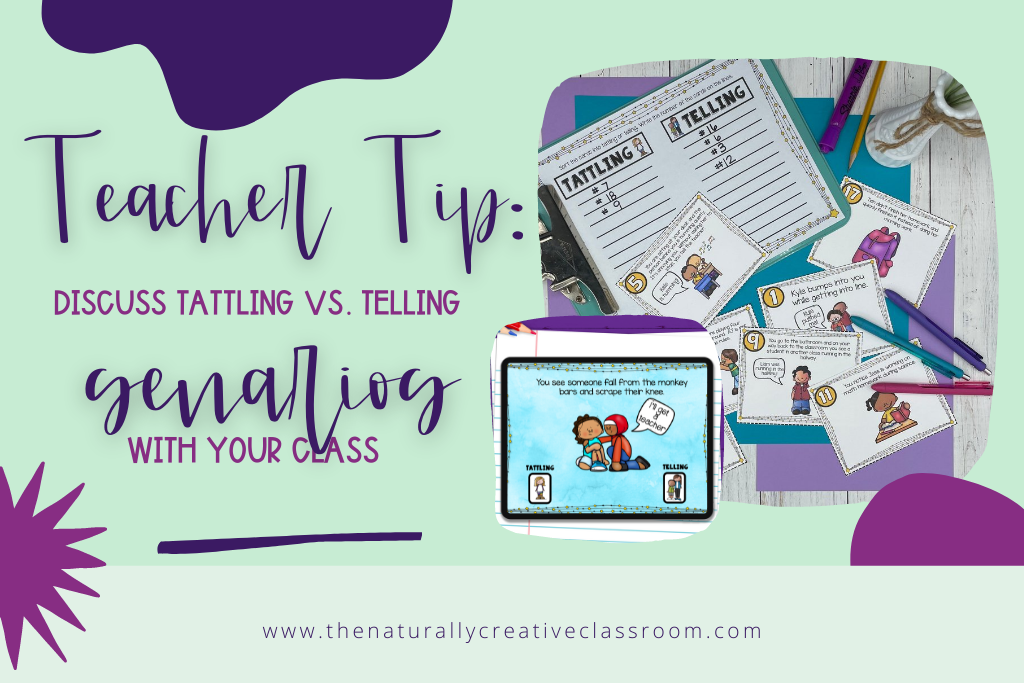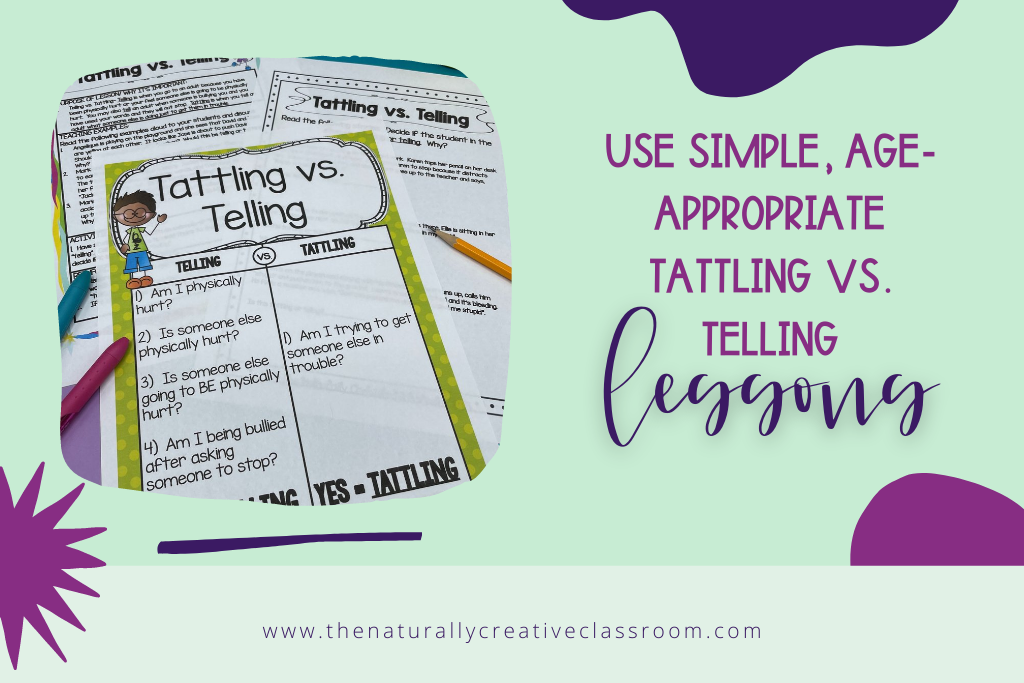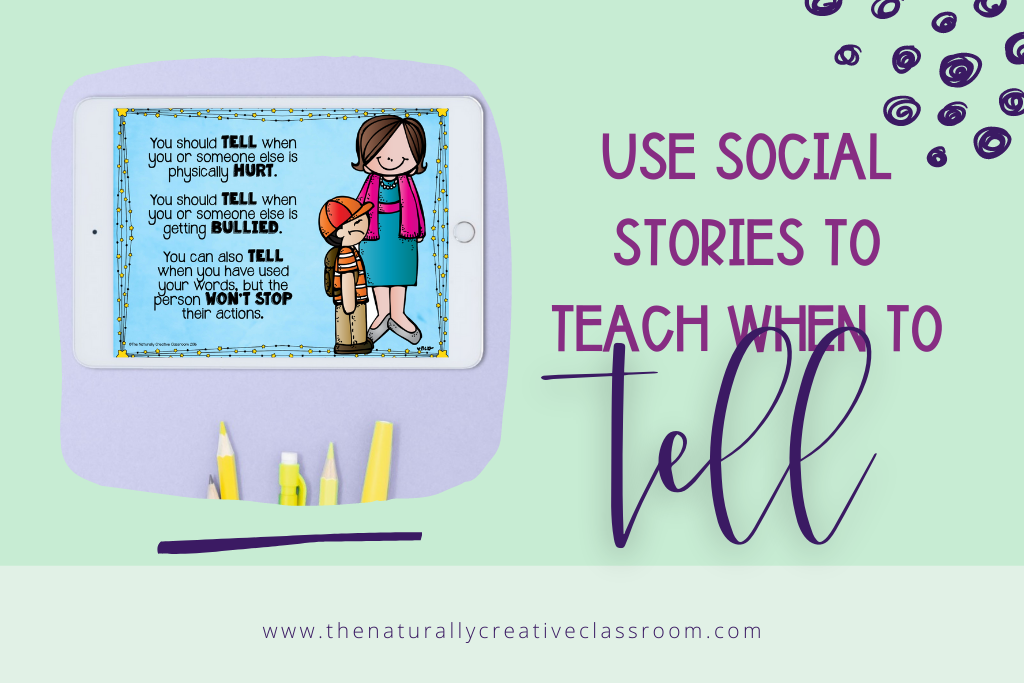Telling vs. tattling- I have definitely listened to my share of tattling in my fifteen years of teaching every grade K-5. Of all the tattling I have heard, ONE DAY as a sub really stands out in my mind as the ultimate tattle fest. I was subbing in a kindergarten classroom, and the tattling came in fast and furious! “She touched my backpack!”, “I was in line first!”, “He isn’t waiting his turn!”
At this point, I had already taught first grade for four years and had two littles at my house, yet the breadth and depth of tattling from these kiddos were exhausting!
By the time 10:00 rolled around, I KNEW this was going to be a long day. Over the lunch period, I cued up my Telling vs. Tattling story slideshow- one of the easiest ways I have found to help curb all the tattling. When they returned from lunch, I set about teaching them the difference between tattling and telling, doing a few examples, and then giving some reminders throughout the rest of the day. As a teacher, constant tattling can be one of the most frustrating habits.
It’s easy to tell the difference between tattling vs. telling in the younger grades but can be harder to address in older stages. As an adult, you need the perspective that tattlers may have had their feelings hurt and may need help learning how to deal with the situation. Let me share with you some of the tips and tricks I have learned.
Reporting vs. tattling: Why the difference is difficult for kids
It is much easier to develop patience and understanding when I know the “why” behind something. Here, the brain development piece is helpful. According to Jamie Howard, Ph.D., little kids’ brains are developed enough to learn a set of black and white rules, but not the nuance in those rules. For example, before teaching empathy and understanding, we make rules such as “Use kind words,” “wait your turn,” “Hands are for helping.” We often do praise our children or students for following these rules, especially when they are small. As a parent or teacher, how often have you said, “Good job keeping your hands to yourself!” or “You are being so patient!”
It makes sense that they would even expect praise for telling when another kid or student is breaking these rules, even if it means that no one is getting hurt. We need to teach them not to tattle on kids while at the same time explaining the difference between reporting and tattling. Learning the difference can be confusing for developing brains.
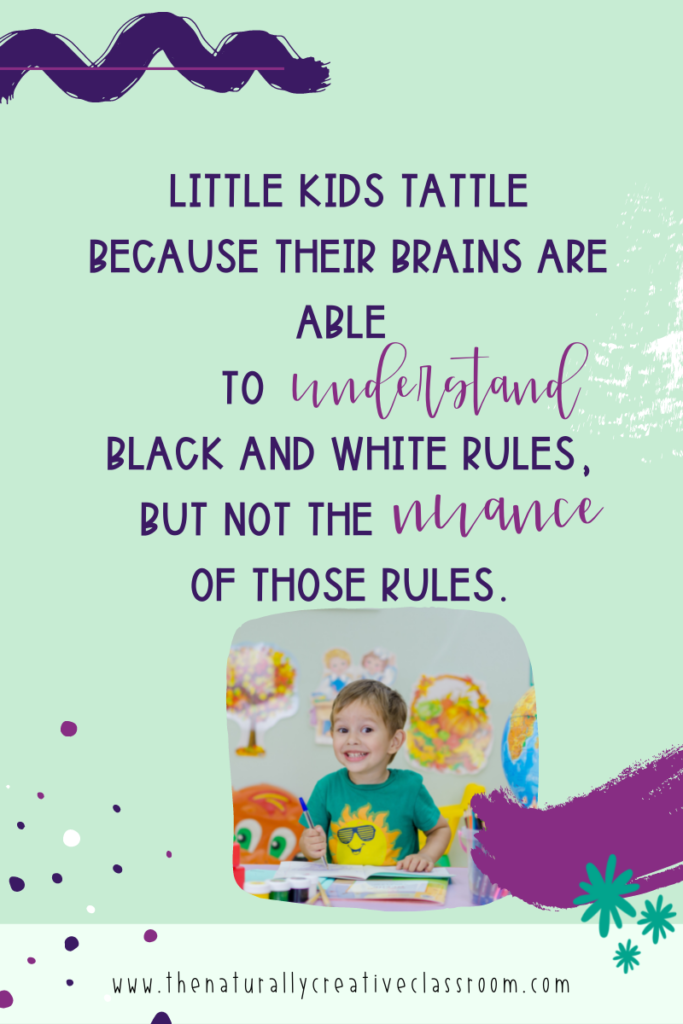
Why kids tattle
Kids tattle for various reasons, only one of them being that they don’t understand the difference between tattling and telling. Kids may also tattle because:
- to get another person in trouble
- to be mean spirited
- for attention/praise from adults
Frequently, we inadvertently praise children for tattling, giving them the attention that it doesn’t deserve. Whatever we pay attention to will grow, and giving tattling attention can make it balloon in our classrooms and houses.
Are you Tattling or telling: HOw to know
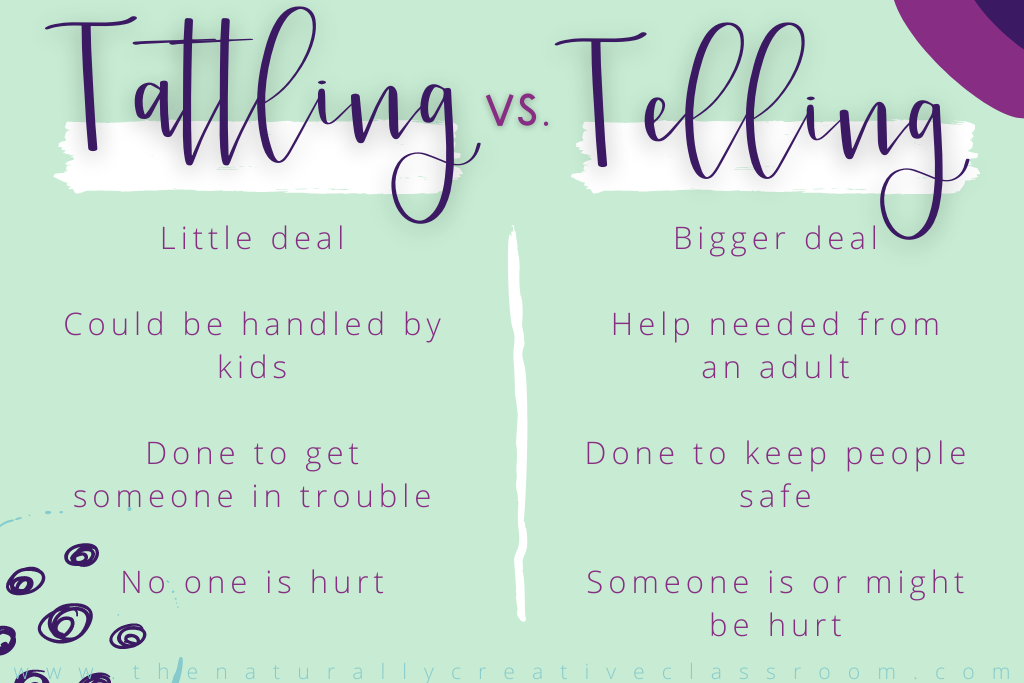
The simple definition I like to tell if you are tattling is “Tattling is when you haven’t used your words, no one is hurt, and no one is going to be hurt, either physically or emotionally. You might want to just get someone in trouble”. Telling a teacher about a small broken rule that isn’t hurting anyone is tattling.
On the other hand, telling is “Someone is hurt or will be hurt, physically or emotionally. You tell when you want to keep yourself or others safe, and you might need help from an adult to solve the problem.” Keep in mind that there are different types of bullying, so the hurt isn’t always visible.
Kids might be reluctant to tell, even when they need to. They may be afraid that they will get in trouble, their friend may get in trouble, or reveal a trusted secret. It is essential to keep an atmosphere of acceptance and assure kids that you will not be angry at them if they tell you something important.
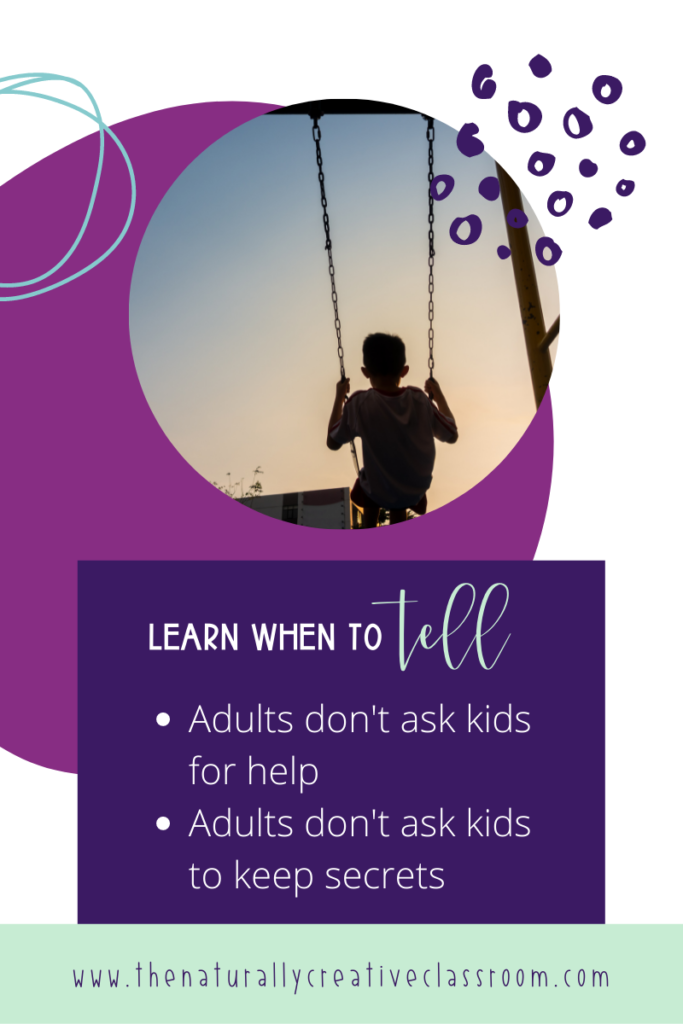
When to Always tell
Teach your kids and students that there are times that they should ALWAYS tell, no matter what.
1. Kids should always tell if they see another student bringing a dangerous weapon to school or if another student talks about bringing a dangerous weapon to school. They should tell if a student talks about hurting themselves or others. Adults should take this type of talk and action seriously.
2. The following two rules to teach your kids fall under the same umbrella. The first is “Adults don’t ask kids for help.” This rule does have nuance and mainly applies to people outside your immediate “bubble,” but it is an excellent general rule. An adult (especially one you don’t know) should never ask a kid to go with them, help them find a puppy, ask for directions, etc. If this happens, they should tell a trusted adult.
3. My other big rule is “Adults don’t ask kids to keep secrets.” Again, there is nuance, especially around holidays and birthdays, but most adults don’t ask kids to keep secrets as a general rule of thumb.
After watching the video below, I have run different scenarios by my kids, and it is surprising how often they say they would help or go with a stranger.
Giving kids language for tattling vs. reporting
Kids might tattle because they don’t have the language to express their feelings first. We teach “Talk and Squawk” to encourage students to use their words first before getting an adult. I use “I feel” statements to give them the language. We came up with a list of “feeling words” that they could put into this sentence.
For example, if someone is humming behind you and you are annoyed, you could say, “I feel distracted when you hum. Can you please stop?”
Including the question piece is essential, and it requires the “offending” student to acknowledge the request and respond. If the behavior continues, THEN it is OK to tell a teacher.
Other language a student could use could be:
- “I can feel you bump into me when you move in line. Can you please stop moving in line?”
- “I don’t like it when you ____. Please stop.”
- “I’m still playing with that toy. Can I please have it back?”
- “Yes, that does go against our rule. Would you please remind them or ignore it?
Next, we read some tattling vs. telling examples and talked through them as a class. Was it tattling or telling, and why? If it was tattling, how could the situation have been handled differently? These scenarios give us a chance to practice some of what we have just learned. As the year goes on, I come back to scenarios and add new ones as they come up in class.
How to deal with tattling in the classroom
My mantra is, “Whatever you focus on will grow.” If you focus on tattling, tattling will grow. But how to deal with tattling in the classroom? You feel like you HAVE to say something! After teaching students the difference between tattling and telling, hang a tattling or telling poster in your room. Refer back to the poster as needed. Ask the student doing the tattling to reflect- “Is someone hurt? Is someone going to be hurt? Why are you telling me this?” Students are bright, and nine times out of ten know immediately if they are tattling. The other one kid might just need some help brainstorming language or problem-solving solutions.
Remember to affirm when kids tell you something important. You need not announce it to the class (if you want to, ask the student first); a phone call home praising the student is a great way to acknowledge when they have told you something important. It may have been difficult for them.
3 effective Tattling vs. telling activities
Here are my favorite telling vs. tattling activities. I have used them for many, many years with success. Students refer back to them all year long, and I use them in small groups or one-on-one if needed.
1. Tattling vs. Telling Lesson Plan
2. Tattling vs. Telling Social Story
This presentation is my most popular tattling vs. telling resource I use when subbing or as needed for my own class and children at home. It provides a more in depth child friendly definition of tattling and telling, scenarios that you can talk through with your class or small group, when to always tell, and “I feel ____. Can you please” statements. It is a digital PowerPoint and Google Slide that you can present to your class or print out and read like a book. You can use alone or with the other resources.
3. Tattling vs. Telling Sorting Task and Boom Cards
20 scenarios are presented and kids must decide if it is telling or tattling. They come as printable task cards or digital Boom Cards. The digital boom cards include sound so that even younger kids can do this tattling vs. reporting activity independently. These boom cards gamify the learning of this concept. Learn more about gamification here.


